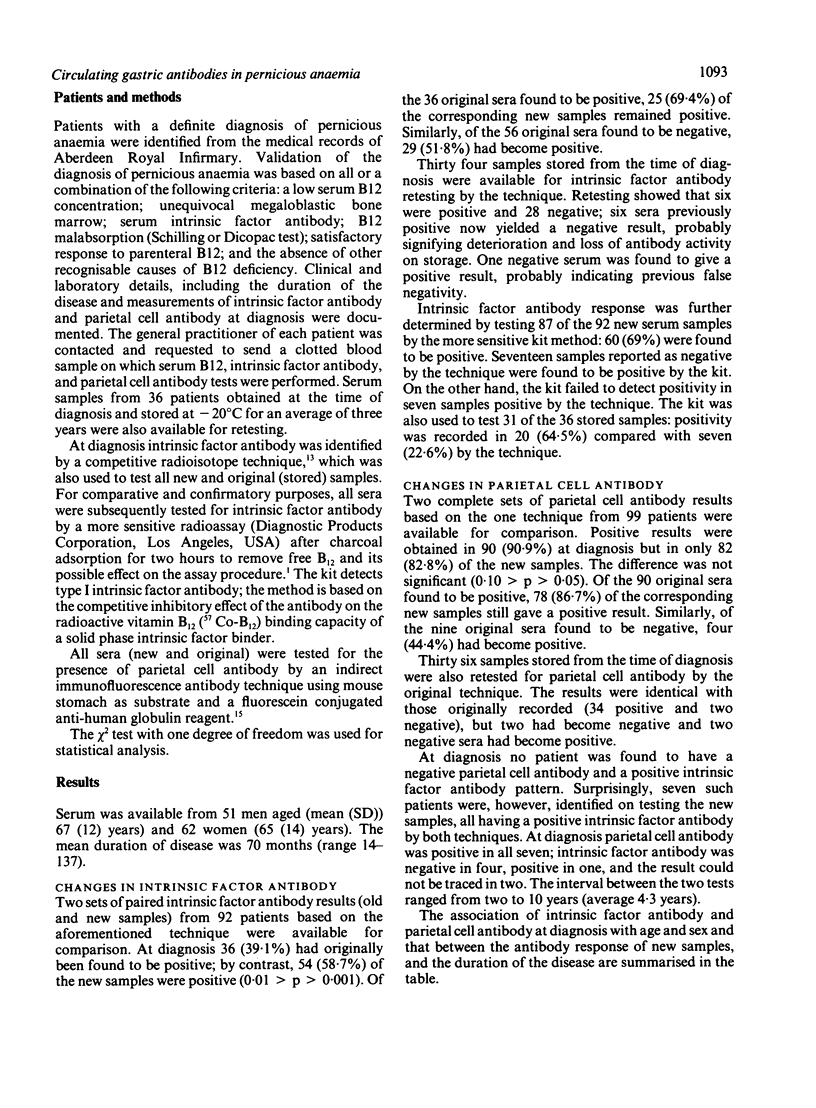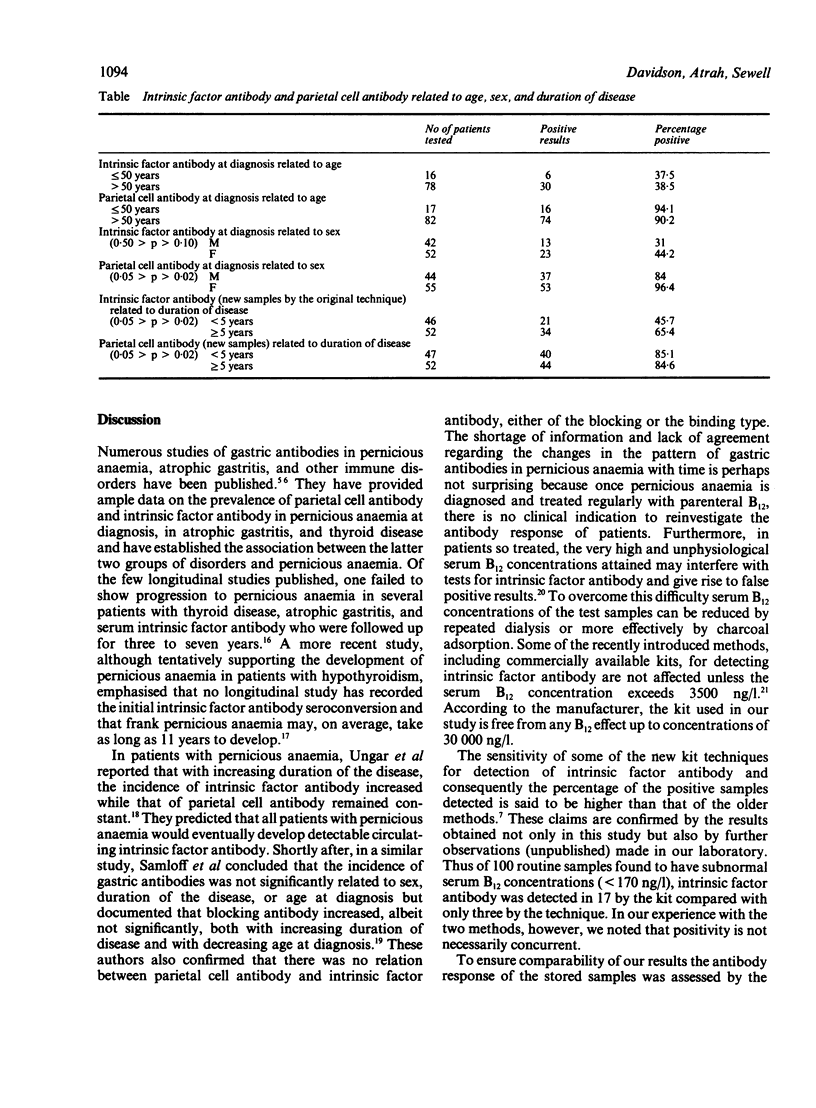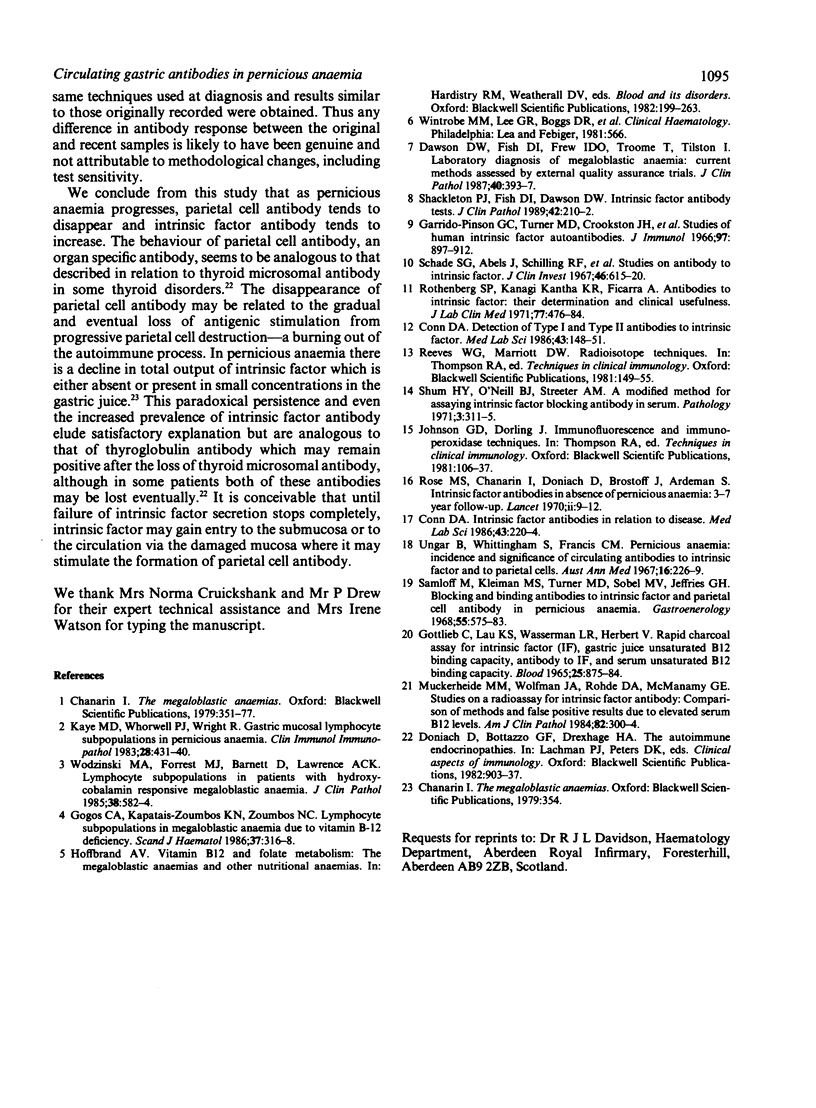Abstract
Temporal changes in gastric antibody response were investigated in 113 (51 men, 62 women) patients with confirmed pernicious anaemia. Their ages ranged from 31-92 years (mean (SD 13.2) 66). At diagnosis, parietal cell antibody and intrinsic factor antibody were detected in 90.9% and 39.1% of all patients, respectively. When the tests were repeated after a mean follow up of 70 months (range 14-137), parietal cell antibody and intrinsic factor antibody were positive in 82.8% and 58.7%, respectively. There was a definite but not significant trend for the organ specific parietal cell antibody to disappear; intrinsic factor antibody became more positive. These results may indicate that with progressive parietal cell destruction, the antigen is no longer available to sustain an immunological response. On the other hand, this hypothesis does not explain the increased prevalence of intrinsic factor antibody which is also a product of parietal cells.
Full text
PDF



Selected References
These references are in PubMed. This may not be the complete list of references from this article.
- Conn D. A. Detection of type I and type II antibodies to intrinsic factor. Med Lab Sci. 1986 Apr;43(2):148–151. [PubMed] [Google Scholar]
- Conn D. A. Intrinsic factor antibodies in relation to disease. Med Lab Sci. 1986 Jul;43(3):220–224. [PubMed] [Google Scholar]
- Dawson D. W., Fish D. I., Frew I. D., Roome T., Tilston I. Laboratory diagnosis of megaloblastic anaemia: current methods assessed by external quality assurance trials. J Clin Pathol. 1987 Apr;40(4):393–397. doi: 10.1136/jcp.40.4.393. [DOI] [PMC free article] [PubMed] [Google Scholar]
- GOTTLIEBLAU K. S., WASSERMAN L. R., HERBERT V. RAPID CHARCOAL ASSAY FOR INTRINSIC FACTOR (IF), GASTRIC JUICE UNSATURATED B12 BINDING CAPACITY, ANTIBODY TO IF, AND SERUM UNSATURATED B12 BINDING CAPACITY. Blood. 1965 Jun;25:875–884. [PubMed] [Google Scholar]
- Garrido-Pinson G., Turner M. D., Crokston J. H., Samloff I. M., Miller L. L., Segahl Studies of human intrinsic factor auto-antibodies. J Immunol. 1966 Dec;97(6):897–912. [PubMed] [Google Scholar]
- Gogos C. A., Kapatais-Zoumbos K. N., Zoumbos N. C. Lymphocyte subpopulations in megaloblastic anaemia due to vitamin B-12 deficiency. Scand J Haematol. 1986 Oct;37(4):316–318. doi: 10.1111/j.1600-0609.1986.tb02319.x. [DOI] [PubMed] [Google Scholar]
- Kaye M. D., Whorwell P. J., Wright R. Gastric mucosal lymphocyte subpopulations in pernicious anemia and in normal stomach. Clin Immunol Immunopathol. 1983 Sep;28(3):431–440. doi: 10.1016/0090-1229(83)90110-1. [DOI] [PubMed] [Google Scholar]
- Muckerheide M. M., Wolfman J. A., Rohde D. A., McManamy G. E. Studies on a radioassay for intrinsic factor antibody: comparison of methods and false positive results due to elevated serum B12 levels. Am J Clin Pathol. 1984 Sep;82(3):300–304. doi: 10.1093/ajcp/82.3.300. [DOI] [PubMed] [Google Scholar]
- Rose M. S., Doniach D., Chanarin I., Brostoff J., Ardeman S. Intrinsic-factor antibodies in absence of pernicious anaemia. 3-7 year follow-up. Lancet. 1970 Jul 4;2(7662):9–12. doi: 10.1016/s0140-6736(70)92473-6. [DOI] [PubMed] [Google Scholar]
- Rothenberg S. P., Kantha K. R., Ficarra A. Autoantibodies to intrinsic factor: their determination and clinical usefulness. J Lab Clin Med. 1971 Mar;77(3):476–484. [PubMed] [Google Scholar]
- Samloff I. M., Kleinman M. S., Turner M. D., Sobel M. V., Jeffries G. H. Blocking and binding antibodies to intrinsic factor and parietal call antibody in pernicious anemia. Gastroenterology. 1968 Nov;55(5):575–583. [PubMed] [Google Scholar]
- Schade S. G., Abels J., Schilling R. F. Studies on antibody to intrinsic factor. J Clin Invest. 1967 Apr;46(4):615–620. doi: 10.1172/JCI105563. [DOI] [PMC free article] [PubMed] [Google Scholar]
- Shackleton P. J., Fish D. I., Dawson D. W. Intrinsic factor antibody tests. J Clin Pathol. 1989 Feb;42(2):210–212. doi: 10.1136/jcp.42.2.210. [DOI] [PMC free article] [PubMed] [Google Scholar]
- Smitananda N., McRae J., Nelson D. S. Erythropoiesis in mice with graft-versus-host reaction: 59 Fe distribution in normal and x-irradiated mice and mice with graft-versus-host reaction. Pathology. 1971 Jan;3(1):31–38. doi: 10.3109/00313027109071319. [DOI] [PubMed] [Google Scholar]
- Ungar B., Whittingham S., Francis C. M. Pernicious anaemia: incidence and significance of circulating antibodies to intrinsic factor and to parietal cells. Australas Ann Med. 1967 Aug;16(3):226–229. doi: 10.1111/imj.1967.16.3.226. [DOI] [PubMed] [Google Scholar]
- Wodzinski M. A., Forrest M. J., Barnett D., Lawrence A. C. Lymphocyte subpopulations in patients with hydroxocobalamin responsive megaloblastic anaemia. J Clin Pathol. 1985 May;38(5):582–584. doi: 10.1136/jcp.38.5.582. [DOI] [PMC free article] [PubMed] [Google Scholar]


